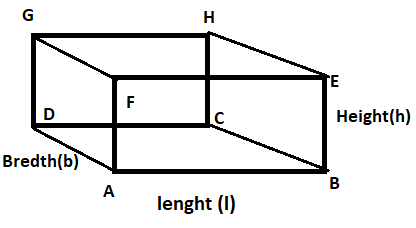
If length, breadth and height of a cuboid are 20cm, 15cm and 10cm respectively, then find :
(a) Area of the base.
(b) Surface area of its vertical faces.
(c) Volume.
Answer
605.4k+ views
Hint:In order to solve this problem, we must use formulas of surface area and volume of Cuboid along with proper understanding of length, breadth and height of cuboid to get the required result.

Complete step-by-step answer:
In the question it is given the length(l) = 20cm, breadth(b) =15cm, height(h)=10cm of cuboid.
(A) Area of base ABCD = length(l) × breadth(b)
So on putting the values of length(l) & breadth(b)
=20×15
=300${\text{c}}{{\text{m}}^2}$.
(B) Surface area of its vertical faces
Here it is total 4 vertical surfaces, ABEF, BEHC, HCDG, AFGD
By observing the given figure, we can say that Surface area of its vertical faces ABEF, HCDG will be equal and will be the length(l) × height(h)
So Surface area of its vertical faces ABEF, HCDG = 2 (length(l) × height(h))
Similarly, by observing the given figure, we can say that Surface area of its vertical faces BEHC, AFGD will be equal and will be the breadth(b) × height(h)
So Surface area of its vertical faces BEHC, AFGD = 2 (breadth(b) × height(h))
So Total Surface area of its vertical faces =
2 (length(l) × height(h)) + 2 (breadth(b) × height(h))
=2(lh+bh)
So on putting all the values
= 2(20×10+15×10)
=2×350
=700 ${\text{c}}{{\text{m}}^2}$.
(C) we know that the Volume of cuboid is equal to length(l) × breadth(b) × height(h)
So on putting all the value
=20×15×10
=300×10
=3000 ${\text{c}}{{\text{m}}^3}$.
Note: Whenever we face such types of problems the key concept we have to remember is that always remember the formula of Surface area and volume of Cuboid which are stated above, then using those formulas calculate, whatever is asked in question.

Complete step-by-step answer:
In the question it is given the length(l) = 20cm, breadth(b) =15cm, height(h)=10cm of cuboid.
(A) Area of base ABCD = length(l) × breadth(b)
So on putting the values of length(l) & breadth(b)
=20×15
=300${\text{c}}{{\text{m}}^2}$.
(B) Surface area of its vertical faces
Here it is total 4 vertical surfaces, ABEF, BEHC, HCDG, AFGD
By observing the given figure, we can say that Surface area of its vertical faces ABEF, HCDG will be equal and will be the length(l) × height(h)
So Surface area of its vertical faces ABEF, HCDG = 2 (length(l) × height(h))
Similarly, by observing the given figure, we can say that Surface area of its vertical faces BEHC, AFGD will be equal and will be the breadth(b) × height(h)
So Surface area of its vertical faces BEHC, AFGD = 2 (breadth(b) × height(h))
So Total Surface area of its vertical faces =
2 (length(l) × height(h)) + 2 (breadth(b) × height(h))
=2(lh+bh)
So on putting all the values
= 2(20×10+15×10)
=2×350
=700 ${\text{c}}{{\text{m}}^2}$.
(C) we know that the Volume of cuboid is equal to length(l) × breadth(b) × height(h)
So on putting all the value
=20×15×10
=300×10
=3000 ${\text{c}}{{\text{m}}^3}$.
Note: Whenever we face such types of problems the key concept we have to remember is that always remember the formula of Surface area and volume of Cuboid which are stated above, then using those formulas calculate, whatever is asked in question.
Recently Updated Pages
Why are manures considered better than fertilizers class 11 biology CBSE

Find the coordinates of the midpoint of the line segment class 11 maths CBSE

Distinguish between static friction limiting friction class 11 physics CBSE

The Chairman of the constituent Assembly was A Jawaharlal class 11 social science CBSE

The first National Commission on Labour NCL submitted class 11 social science CBSE

Number of all subshell of n + l 7 is A 4 B 5 C 6 D class 11 chemistry CBSE

Trending doubts
What is meant by exothermic and endothermic reactions class 11 chemistry CBSE

10 examples of friction in our daily life

One Metric ton is equal to kg A 10000 B 1000 C 100 class 11 physics CBSE

1 Quintal is equal to a 110 kg b 10 kg c 100kg d 1000 class 11 physics CBSE

Difference Between Prokaryotic Cells and Eukaryotic Cells

What are Quantum numbers Explain the quantum number class 11 chemistry CBSE




